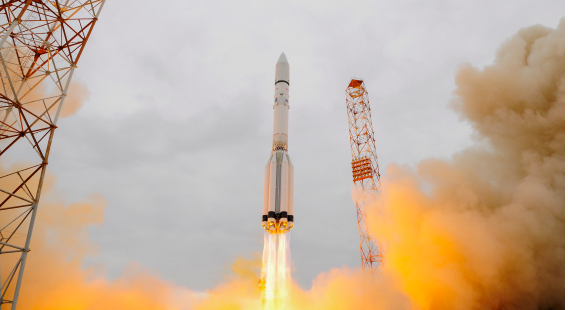On 14 March 2016 the ExoMars Trace Gas Orbiter (TGO) spacecraft was launched from Baikonur in Kazakhstan on a seven month mission to Mars. When it arrives at the red planet, it will study how the distribution of the gas methane varies according to position on the planet’s surface and over the course of time.
Image from ESA
What is the significance of methane on Mars?
Compared to the Earth, Mars has a very thin atmosphere. Its surface pressure is only 0.6% of that of the Earth. The atmosphere mainly consists of carbon dioxide. However, it also contains a small amount of methane (around 0.000001%) (ESA 2004). This is a puzzle to scientists because the ultraviolet light from the Sun should break up any methane within 600 years, and Mars is 4.5 billions old. Therefore there must be some process occurring on Mars which is constantly replenishing the methane.
Mars- Image from NASA
There are various possibilities for the origin of this methane. One is that it is released by geological processes such as volcanoes or a chemical process occurring within rocks called serpentinisation. This is not as exciting as it sounds (no snakes, I’m afraid) – it is simply a slow chemical reaction between olivine (a mineral found on Mars) carbon dioxide and water which can produce methane. Another is that there is a large reservoir of methane locked away in the ice below the Martian surface and as the temperature varies some of the ice may melt, thus releasing the methane into the atmosphere.
A fascinating possibility is that the methane is created by microorganisms below the planet’s surface. On Earth more than 90% of methane in the atmosphere is produced by living organisms (ESA 2014). There are over 50 species of microorganisms known as methanogens that live off organic matter and produce methane as a waste product. These microorganisms are found not only in wetlands (producing what is known as marsh gas) and in the soil but also in the guts of many animals such as cows and humans. At the risk of sounding somewhat vulgar, the methane gas escapes from both cattle and ourselves in the form of flatulence.
Methanogens
What will the TGO measure?
The TGO will measure how the methane content of Mars’s atmosphere varies with space and time. It will also be able to measure the concentration of other gases such as sulphur dioxide (which on Earth is normally associated with volcanic activity) and organic compounds such as ethane, methanol and formaldehyde (which on Earth are produced by living organisms). Although the TGO probe won’t be able to say for definite what the sources of the methane found on Mars are, if the concentration of methane were found to vary with the seasons and also if methane were found in conjunction with other organic chemicals it would point towards a biological origin.
How long with the mission be?
The TGO is a joint mission between the European Space Agency (ESA) and the Russian Space Agency (Roscosmos). The mission is described in more detail on ESA’s website (2016). When it arrives at Mars in October 2016 it will take around a year to get into a low circular orbit and then it will spend the next 5 years mapping the methane distribution. It will also have a lander module which will separate from the main orbiter and will land on the surface. The lander will measure the wind speed and direction, humidity, pressure and surface temperature, and determine the transparency of the atmosphere. It will also make the first measurements of electrical fields at the planet’s surface.
Next Post
I hope you have enjoyed this short post. In my next post I will be talking about the Earth’s magnetic field.
The Science Geek
References
ESA (2004) Mars Express Confirms Methane in the Martian Atmosphere, Available at:http://www.esa.int/Our_Activities/Space_Science/Mars_Express/Mars_Express_confirms_methane_in_the_Martian_atmosphere(Accessed: 20 March 2016).
ESA (2014) The enigma of methane on Mars, Available at:http://exploration.esa.int/mars/46038-methane-on-mars/ (Accessed: 20 March 2016).
ESA (2016) Robotic exploration of Mars, Available at:http://exploration.esa.int/mars/46124-mission-overview/ (Accessed: 20 March 2016)




Wow just 6 months to get to Mars? Did they use the alignment of the planets? Probably so. Is this our regular speed of getting to Mars these days given the convenient coxation of the planets?
LikeLike
Location not coxation (sorry, spellcheck’s fault)
LikeLike
Great post! I have written something close to your topic futuremanweb.wordpress.com
LikeLike
Thank you
The Science Geek
LikeLike
[…] Check out this post by The Science Geek. If you like it, check out his posts on Earth’s magnetic field and life on Mars. […]
LikeLike
[…] via Short post of the month – April 2016: Life on Mars? — The Science Geek […]
LikeLike
As a space fan, I must say, your blog is pretty impressive!
LikeLike
Thank you
LikeLike
It might be a little small to fit on.
LikeLike
Hands up everyone who wants to be on that lander. 😀
LikeLike